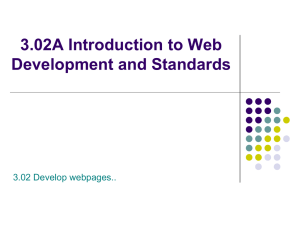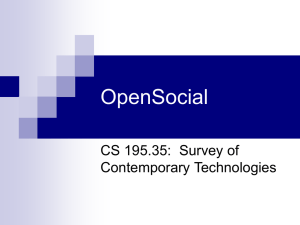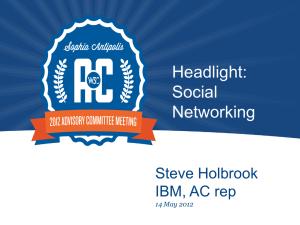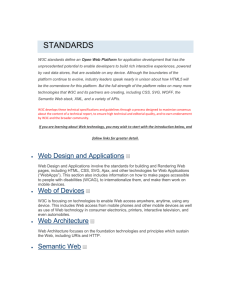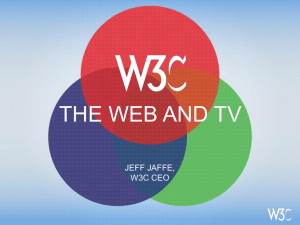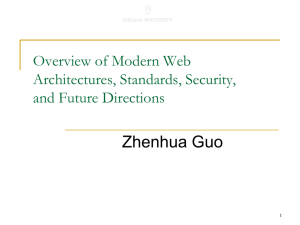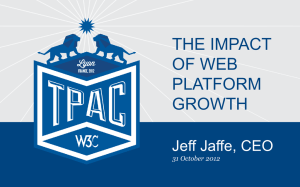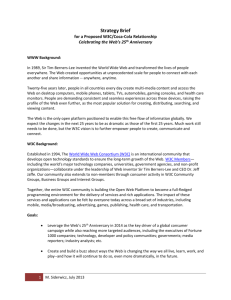Social Business Workshop report draft v1
advertisement
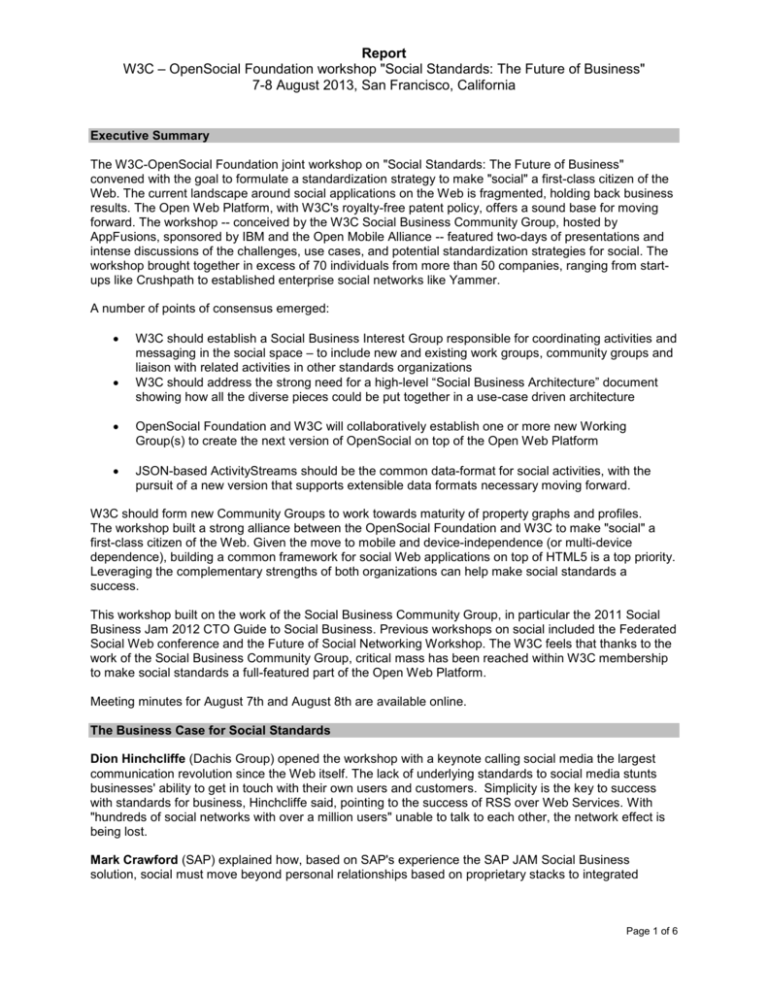
Report W3C – OpenSocial Foundation workshop "Social Standards: The Future of Business" 7-8 August 2013, San Francisco, California Executive Summary The W3C-OpenSocial Foundation joint workshop on "Social Standards: The Future of Business" convened with the goal to formulate a standardization strategy to make "social" a first-class citizen of the Web. The current landscape around social applications on the Web is fragmented, holding back business results. The Open Web Platform, with W3C's royalty-free patent policy, offers a sound base for moving forward. The workshop -- conceived by the W3C Social Business Community Group, hosted by AppFusions, sponsored by IBM and the Open Mobile Alliance -- featured two-days of presentations and intense discussions of the challenges, use cases, and potential standardization strategies for social. The workshop brought together in excess of 70 individuals from more than 50 companies, ranging from startups like Crushpath to established enterprise social networks like Yammer. A number of points of consensus emerged: W3C should establish a Social Business Interest Group responsible for coordinating activities and messaging in the social space – to include new and existing work groups, community groups and liaison with related activities in other standards organizations W3C should address the strong need for a high-level “Social Business Architecture” document showing how all the diverse pieces could be put together in a use-case driven architecture OpenSocial Foundation and W3C will collaboratively establish one or more new Working Group(s) to create the next version of OpenSocial on top of the Open Web Platform JSON-based ActivityStreams should be the common data-format for social activities, with the pursuit of a new version that supports extensible data formats necessary moving forward. W3C should form new Community Groups to work towards maturity of property graphs and profiles. The workshop built a strong alliance between the OpenSocial Foundation and W3C to make "social" a first-class citizen of the Web. Given the move to mobile and device-independence (or multi-device dependence), building a common framework for social Web applications on top of HTML5 is a top priority. Leveraging the complementary strengths of both organizations can help make social standards a success. This workshop built on the work of the Social Business Community Group, in particular the 2011 Social Business Jam 2012 CTO Guide to Social Business. Previous workshops on social included the Federated Social Web conference and the Future of Social Networking Workshop. The W3C feels that thanks to the work of the Social Business Community Group, critical mass has been reached within W3C membership to make social standards a full-featured part of the Open Web Platform. Meeting minutes for August 7th and August 8th are available online. The Business Case for Social Standards Dion Hinchcliffe (Dachis Group) opened the workshop with a keynote calling social media the largest communication revolution since the Web itself. The lack of underlying standards to social media stunts businesses' ability to get in touch with their own users and customers. Simplicity is the key to success with standards for business, Hinchcliffe said, pointing to the success of RSS over Web Services. With "hundreds of social networks with over a million users" unable to talk to each other, the network effect is being lost. Mark Crawford (SAP) explained how, based on SAP's experience the SAP JAM Social Business solution, social must move beyond personal relationships based on proprietary stacks to integrated Page 1 of 6 Report W3C – OpenSocial Foundation workshop "Social Standards: The Future of Business" 7-8 August 2013, San Francisco, California "business" relationships based on standards. The vast majority of business related processes are nontransactional in nature requiring social interaction involving people, content, applications, data and processes (learning, internal communities, HR management, supply chains, onboarding new employees). It is essential that these social processes are integrated into business applications to accelerate real business performance rather than be lost in the "black hole" of traditional interactions. Since companies employ many diverse packages of software across heterogeneous environments, semantic standards around social business content and the contextualization of that content are the way forward. Ed Krebs (Ford) followed by detailing a reference architecture that illustrated the current landscape fragmentation and the possibilities for a unified architecture. Such a unified architecture will significantly ease the effort required by engineers to build enterprise social networks that can successfully interoperate both within and between large and small enterprises such as Ford and its supply chain. Storing files in multiple places is not efficient, and "nuggets of wisdom" are lost that are crucial to the business. Don Buddenbaum (IBM) presented on how 'social' has to be embedded where people do their work, with metrics included so businesses can understand the concrete results of using social. Lloyd Fassett (Azteria) gave a presentation on how social standards could enable businesses to move from "pipes to platforms" that enable a business to make better choices in use-cases such as health-care staffing. Use-cases The Workshop then turned to the question of what concrete use-cases could be addressed using social standards? Li Ding (Memect) provided an analysis suggesting that all use-cases could be thought in terms of providing an extended memory for a business. Monica Wilkinson (Crushpath) discussed how standards help start-ups ship working code faster, saying that her start-up deploys a vast variety of standards, ranging from de-facto closed work such as the Open Graph Protocol (Facebook's "Like" Button) to community-driven work like ActivityStreams. Eric Meeks (University of San Francisco) argued that Linked Data complements OpenSocial, and demonstrated how it enables academic social networking. Adam Boyet (Boeing) pointed out how their custom-built InSite social platform allows "connections everywhere" to enable both internal and external collaboration and expert-finding for Boeing, but authentication and federation of identity profiles were major pain-points in integrating InSite with other products like Microsoft SharePoint. Dan Schutzer (FSTC) reminded the audience that deployment in the financial sector depended on privacy and security to protect users, as well as a focus on risk and compliance that are necessary to deal with anti-fraud and disclosure requirements. The group at large engaged in a detailed discussion that focused on expert-finding, as well as identifying the right context for expertise. The group also discussed the difference between emerging social platforms and traditional collaboration software, with the key difference being that collaboration software is focused on pre-existing teams while Page 2 of 6 Report W3C – OpenSocial Foundation workshop "Social Standards: The Future of Business" 7-8 August 2013, San Francisco, California social software is meant to help a business discover connections that it might not even be aware of -both between the employees of a business and between a business and its customers. Social Standards Architecture Monica Lam (Stanford University) gave the topic keynote on "How Mobile Revolutionizes Social" raised the case that mobile could revolutionize social, as phones are essentially thin clients to social networks. Lam followed with a demonstration of an application that let users create their own ad-hoc social networks without servers based on their phone. Her presentation highlighted a fundamental Social Business question that needs to be addressed – As social standards are currently spread across multiple standards-bodies and grass-roots efforts, how can we unite them into a coherent "social platform" built on top of the Open Web Platform? Bryan Sullivan (AT&T) noted that a social architecture would have to scale globally in a mobile environment, and demonstrated how the Open Mobile Alliance had already constructed a draft architecture (SNEW) based on pre-existing work such as OStatus. There was still much work to be done, such as integration with NFC and multi-factor authentication, and ActivityStreams templates were needed to standardize various common workflows. Lastly, user control and privacy were still major open issues. Fabio Mondin (Telecom Italia) focused on how mobile social networking would increase network efficiencies by demonstrating how their work with the eCousing project allowed reduced network usage by, for example, placing social content closer to the location of the event. To enable these kinds of usecases, the social networking architecture needs to be able to communicate with the networking architecture. Jason Gary (IBM) pointed out how events and roles need to be embedded in ActivityStreams, but currently profiles do not support roles despite roles having the ability to be the "killer app" for social. Gary sees a solution through creation of a general event and data model for use by application developers, leveraging existing standards and technologies including PubSub (MQTT), Linked Data (JSON-LD) and Message Payload (Activity Streams).Discussion over the importance of roles between roles ensued. Ashok Malhotra (Oracle) brought up the fact that the back-end of social networking sites store massive property graphs, a graph-based data-structure where lists of properties are attached to each node. Currently the details are different for how each vendor stores property graphs, and Oracle would be willing to make a submission to the W3C to start work in standardizing them. It is currently unclear how much of property graphs could be handled by the RDF data model. Federating the Social Web Matt Franklin (W20 Digital) started with a call to action on how a new generation of standards to federate the social web, building on top of OpenSocial and ActivityStreams, would be necessary. In particular, OpenSocial does not address identity and the social graph, and ActivityStreams needs to have better interoperability with processing rules and levels of visibility. Gregg Kellogg (Organization) discussed how, given that the proposed next version of ActivityStreams is using the JSON-LD format, and JSON-LD adds URIs and links to JSON, JSON is compatible with the RDF data model. Ed Krebs (Ford) made the case federated architectures require what he terms a "PubSubHub" system wherein new business systems will be able to feed data to each other without changing other servers. Page 3 of 6 Report W3C – OpenSocial Foundation workshop "Social Standards: The Future of Business" 7-8 August 2013, San Francisco, California Sam Goto (Google) discussed how schema.org was being extended to take on actions (essentially a taxonomy of verbs), similar to the "Embedded Experiences" of OpenSocial where verbs can take on welldefined subjects and objects with semantic roles. Theodoros Michalareas (VELTI) presented a research paper developed as a part of the EU-funded project OPENi (Open-Source, Web-Based, Framework for Integrating Applications with Social Media Services and Personal Cloudlets. The paper makes a strong case for the OPENi API, which provides for 1) a social graph-rooted, OPENi Graph API framework that builds on existing social standards and allows developers to easily source into their applications a broad spectrum of existing cloud-based, user-centric functionality and content and 2) a Context API framework that allows to build context to the developed applications and extend the social graph connectivity model so that consumers can express both weight and connectivity of their connection to other parts of the social graph. Considerable discussion over the choice of data-formats (HTML with Microformats2, JSON-LD, and ordinary JSON) as well as the relationship of context to security concerns also took place. Next Steps for OpenSocial OpenSocial is the foremost API for enterprise social applications, and its evolution will help drive the open social web. Mark Weitzel (Jive) and Andy Smith (IBM) gave an OpenSocial "State of the Union" address, in which they laid out the plan for building the next version of OpenSocial on top of the Open Web Platform. OpenSocial has always been focused on securely sharing context bi-directionally with applications. A new version of OpenSocial that builds on top of Shadow DOM and Web Components will let developers build OpenSocial applications in the same style as any other HTML5 application while maintaining OpenSocial's ability to share context and create "embedded experience" that prevent users from losing their context. Beth Lavender (MITRE) built on Mark and Andy’s points and discussed how their work allowed MITRE to view a business either at a particular point in time or view the business as activities were occurring in "real-time." Ellen Feaheny (AppFusions and workshop host), discussed how AppFusions makes standards like OAuth talk to each other in their rapid integration of Jive, IBM, and Atlassian applications. Shane Caraveo (Mozilla) presented Mozilla's new "Social API" that embeds capabilities to the user agent's sidebar such as notifications, social bookmarking, share, and chat windows. Dimitri Glazkov (Google) then gave an in-depth presentation on Web Components, which led to considerable excitement on how OpenSocial could work together with Web Components and other new capabilities being developed in HTML5. Running Code The workshop hosted a session of demonstrations of running code that was inspired by the "IndieWeb Camps" and "Federated Social Web Summits", Tantek Çelik (Organization) began by introducing the idea of "IndieWeb", based on the twin principles of Own your own data, Eat your own dog food, and Publish Own Site, Syndicate Elsewhere. Page 4 of 6 Report W3C – OpenSocial Foundation workshop "Social Standards: The Future of Business" 7-8 August 2013, San Francisco, California Aaron Pareki (Organization) showed how by running his own domain he could be his own identity server (IndieAuth), and then with Bret Comnes (Organization) demonstrated how a watch could be used to authenticate into a site @@. Evan Prodromou (Status.Net) presented his new "Pump.io" codebase for an ActivityStreams server with varying degrees of privacy, allowing streams to be filtered and writable only to certain groups. Ben Werdmueller (Lakatoo) presented Idno, a social publishing platform built just on top of HTML5 and microformats. Users should be put first, and beware of putting technology before usability. Patrick Deegan (ID3) demonstrated Open Mustard Seed that uses virtual machines to created trusted applications bundles. Their goal is to create a new social ecosystem of trusted digital institutions based on personal data. Access control (distribution control of ActivityStreams) and consumption of ActivityStreams were mentioned as outstanding problems, with a client API for ActivityStreams and WebMention brought up as possible solutions. Next Steps At the end of the workshop, break-out groups met to discuss areas to be standardized next. Groups formed around the following topics: OpenSocial and Gadgets will focus on radical simplification leveraging HTML5, moving from the XML definition of a gadget to a situation where AJAX requests are performed directly against a page. How context works with cross-origin requests and how application tags can be supported by HTML5 are the next steps. ActivityStreams will focus on a new version, ActivityStreams 2.0, to increase extensibility and handle state. The role of JSON-LD as a syntax for ActivityStreams achieved consensus although ActivityStreams 2.0 does not depend on it. Identity and Profile Federation needs to focus on a set of core attributes that show how previous work in the area (vCard, Microformats, PortableContacts) can be extended with desired features such as skill-levels and certifications. It is necessary to understand how profiles federate using protocols such as Pubsubhubbub. IndieWeb will focus on user experience, in particular making it much easier to use the reply button and work with browsers to make it easier to share content. Property Graphs need to have their data model defined, as well as APIs and schemas. Potential cross-over work on exploiting property graphs with the OpenSocial API should be investigated. Linked Data and vocabularies need to focus on how to create new kinds of vocabularies that can enable social business, such as expertise vocabularies. Additionally R.V. Guha (Google) came to answer questions about licensing and transparency of schema.org. Guha noted that data a company marks up using schema.org microdata still belongs to the website, and so that data cannot be re-used without that website's permission, but that he would investigate whether changes to the schema.org terms of use were warranted. Interest in following through with each of above topics was fairly well distributed, with more than ten people interested in continuing concrete work on each as follows: Page 5 of 6 Report W3C – OpenSocial Foundation workshop "Social Standards: The Future of Business" 7-8 August 2013, San Francisco, California W3C Transform the Social Business Community Group into a W3C Social Business Interest Group chartered to handle messaging and co-ordination responsibilities for all activities. W3C develop a high-level "Social Business Architecture" document showing how all the diverse pieces could be put together in a use-case driven architecture W3C form new Working Groups on ActivityStreams, OpenSocial, and possibly federation W3C form new Community Groups to work towards maturity of Property Graphs and Profile work Schema.org would continue to work with W3C and other grassroots communities to make its process more open and transparent for vocabularies. Conclusion All participants are invited to join the Social Business Community Group and help draft the charters for new work. Other interested parties can also join the SBCG and participate in this exciting area as the future of social business on top of the Web is planned and built. The W3C does not require membership to participate in the community groups, and this is a good opportunity to get yourself in on the ground floor to both guide the direction and evaluate if a stronger role as a W3C member in these new activities is important for you. Page 6 of 6
